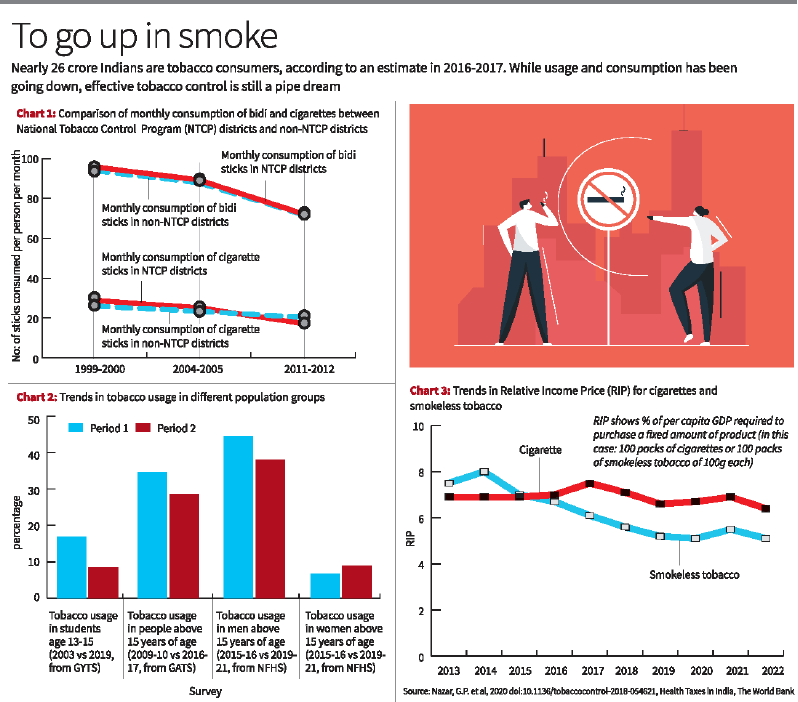Description

Source: Hindu
Disclaimer: Copyright infringement not intended.
Context
- Tobacco is the most widely recognized preventable cause of disease and death globally.
- It affects not only those who consume it but also those who cultivate it.
- In India, the tobacco epidemic presents a multifaceted challenge, impacting public health, the environment, and the economy.
Details
Tobacco Use in India
Prevalence and Demographics
- High Consumption: India has the second-highest number of tobacco consumers in the world after China, with nearly 260 million users as of 2016-2017.
- At-Risk Populations: Over 6 million people are employed in the tobacco industry, where exposure to tobacco can lead to various diseases.
Surveys and Data
- Global Adult Tobacco Survey (GATS)and Global Youth Tobacco Survey (GYTS) assess tobacco use among adults and youth respectively.
- National Family Health Survey (NFHS)also captures tobacco use among those above 15 years.
- Recent Trends: Overall tobacco use has decreased, but use among women increased by 2.1% between NFHS 2015-2016 and NFHS 2019-2021.
Impact of COVID-19
- Data Gaps: No comprehensive survey has been conducted since the COVID-19 pandemic, highlighting a need for up-to-date data to track trends and develop strategies.
Health and Environmental Impact
Health Consequences
- Diseases: Tobacco use causes a wide range of diseases, including cancers, respiratory and cardiovascular diseases.
- Occupational Risks: Workers in the tobacco industry face health risks from dermal absorption of nicotine and other chemicals.
Environmental Damage
- Soil Depletion: Tobacco is an erosive crop that rapidly depletes soil nutrients, requiring more fertilizers, which further degrade soil quality.
- Deforestation: Tobacco production contributes to deforestation; processing 1 kg of tobacco requires up to 5.4 kg of wood.
- Waste Generation: Tobacco production and consumption generate approximately 170,000 tonnes of waste annually in India.
Economic Burden
- Healthcare Costs: Tobacco-related health issues cost India over ₹1.7 lakh crore in 2017-2018, exceeding the Union Budget for health of ₹48,000 crore for the same year.
- Waste Management: Cleaning up tobacco waste costs around ₹6,367 crore annually.
Regulation and Control
Legislation
- Framework Convention on Tobacco Control (FCTC): India is a signatory, aiming to reduce tobacco usage through various strategies.
- COTPA 2003 (Cigarettes and Other Tobacco Products Act): Governs production, advertisement, distribution, and consumption of tobacco.
National Tobacco Control Program (NTCP)
- Objectives: Enhance COTPA and FCTC implementation, raise awareness, and support cessation.
- Challenges: Poor implementation, non-compliance with packaging guidelines, and ineffective regulation of smuggled products.
Advertising and Taxation
- Surrogate Advertising: Loopholes allow indirect promotion of tobacco via proxy products.
- Taxation Issues: Low tobacco taxes and ineffective tax administration keep tobacco affordable.

Control Measures and Effectiveness
Proposed Amendments
- 2015: Regulations on surrogate advertisements, inclusion of digital media, increased fines.
- 2020: Licensing for tobacco production, supply, and distribution.
NTCP and Taxation
- Effectiveness: Studies show no significant difference in tobacco consumption between NTCP and non-NTCP districts.
- Tax Measures: Inadequate taxation and issues with tax evasion and illicit trade.
Tobacco Affordability
- Economic Analysis: Tobacco products have become more affordable over the years, undermining public health efforts.
- FCTC Recommendations: Current tax rates are below the recommended 75%.
Lobbying and Industry Influence
- Government Stake: The government holds a 7.8% stake in ITC Ltd., India's largest tobacco company.
- Policy Interference: Effective lobbying has led to exemptions and influenced tobacco control policies.
- Prohibition of Electronic Cigarettes Act 2019: Banned e-cigarettes, yet their use remains a public health challenge.
Recommendations
- Implementation: Stricter enforcement of existing laws and increased fines for violations.
- Taxation: Increase taxes in line with FCTC recommendations, inflation, and GDP growth.
- Crop Diversification: Help tobacco farmers switch to alternative crops, enhancing livelihood sustainability.
- Surveys: Conduct regular and comprehensive surveys to gather up-to-date data on tobacco use trends.
- Research: Invest in studies to understand and counter the tobacco industry's evolving strategies.
About Tobacco
- Tobacco is a product prepared from the leaves of the tobacco plant by curing them. The main types of tobacco products include:
- Smoking tobacco: Cigarettes, cigars, pipe tobacco
- Smokeless tobacco: Chewing tobacco, snuff
History of Tobacco Use
- Ancient Use: Indigenous peoples in the Americas used tobacco in religious and medicinal practices.
- Introduction to Europe: Christopher Columbus brought tobacco to Europe in the late 15th century.
- Commercialization: Tobacco became a major trade commodity in the 17th century.
Global Production and Consumption
- Top Producers: China, India, Brazil, and the United States
- Consumption Patterns: Vary widely across regions, with high rates in some Asian and Eastern European countries.
Primary Chemicals in Tobacco
- Nicotine: The addictive substance found in tobacco.
- Tar: A mixture of chemicals found in tobacco smoke.
- Carbon Monoxide: A harmful gas produced by burning tobacco.
Nicotine and Its Effects
- Stimulant: Increases heart rate and blood pressure.
- Addictive Properties: Causes physical and psychological dependence.
Additives in Tobacco Products
- Flavorings: Enhance taste and appeal.
- Humectants: Keep tobacco moist.
- Ammonia: Increases nicotine absorption.
Sources:
Hindu
|
PRACTICE QUESTION
Q. India's battle against the tobacco epidemic requires a multifaceted approach, combining stringent regulation, effective enforcement, economic measures, and support for affected populations. Comment. (250 Words)
|
















